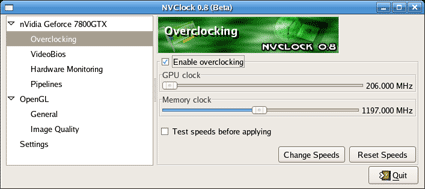Nvidia and GeForce on Linux
Nvidia has been more attentive and thorough in its approach to Linux driver support, especially in terms of capability, support, and stability. Nvidia driver support continues to lead the pack: one major advantage on the desktop for Nvidia customers is a feature-rich set of graphical configuration utilities for configuring X Server. Acquiring Nvidia drivers seldom entails more than consulting a package repository for your Linux distribution of choice, and instructing local package management facilities to fetch, build, and install all required files and dependencies.
Also, overclocking Nvidia cards under Linux involves less mystery and more science. NVClock is the utility of choice for overclocking GeForce series 6 and 7 graphics processor families, and even provides a nice clean interface for fine-tuning graphics card properties. Some of this functionality is derived from the system's own display configuration properties, but includes a few additional tweaks such as slider bars that correspond to GPU and memory clock speeds, as depicted in the series of images that follow. Beware, however, that NVClock has apparently fallen into disrepair, so expect the unexpected.

NVClock: the GeForce overclocking utility for Linux

NVClock GPU and memory overclocking parameters
NVClock issues the following warning for enthusiasts bold enough to try this using current drivers and Xorg software:

NVClock warns against incompatible versions
GeForce and SLI on Linux
Nvidia was first to answer the challenge of dual-graphics arrays for Linux with the release of GeForce graphics drivers version 1.0-8174. Although this first introduction of Nvidia's patented Scalable Link Interface (SLI) parallel graphics processing solution was a landmark success for both Nvidia fans and Linux gamers alike, it lacks the full breadth of features and performance capabilities available in Windows ForceWare versions. For the Linux gaming community, the debut of SLI capability proved to be only a marginal success-but at least driver support was there, even if it was incomplete.
Stay on the Cutting Edge
Join the experts who read Tom's Hardware for the inside track on enthusiast PC tech news — and have for over 25 years. We'll send breaking news and in-depth reviews of CPUs, GPUs, AI, maker hardware and more straight to your inbox.
Current page: Nvidia and GeForce on Linux
Prev Page Radeon and Crossfire on Linux Next Page Test Components and ConfigurationEd Tittel is a long-time IT writer, researcher and consultant, and occasional contributor to Tom’s Hardware. A Windows Insider MVP since 2018, he likes to cover OS-related driver, troubleshooting, and security topics.
Most Popular


